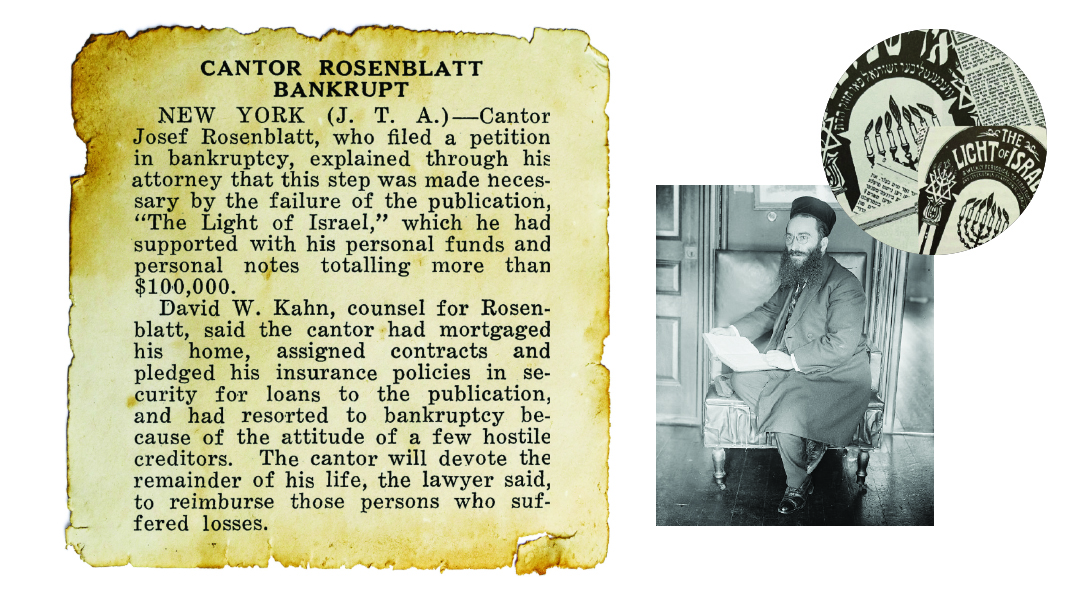A Light Extinguished
| June 1, 2021In 1925, the highest-paid chazzan in the world filed for bankruptcy

Title: A Light Extinguished
Location: New York, NY
Document: Jewish Telegraphic Agency
Time: 1925
Rav Shraga Feivel Mendlowitz and Chazzan Yossele Rosenblatt, two legendary figures in early 20th-century American Jewish life, banded together in 1923 with several others to found a newspaper called Dos Yiddishe Licht or the Light of Israel. The goal of the venture was to spread Torah values and challenge the dominant secular Yiddish press, which often espoused views antithetical to Jewish tradition. To finance the project, the renowned chazzan put up $25,000 of his own money, and Rav Shraga Feivel added $10,000, which he borrowed from friends.
The weekly — later daily — was published in English and Yiddish and included news, inspiration, and a no-holds-barred opinion page. Regular contributors included founding American Agudists as Rabbis Leo Jung and Herbert Goldstein, but the most notable columns were penned by Rav Shraga Feivel himself. Under the name “Shraga Feivish Mendlowitz” (and other pseudonyms) he published seething animadversion on kashrus, Shabbos observance, and the hypocrisy of rival Yiddish newspapers.
While Yossele Rosenblatt took no official role in newspaper operations, as a general partner, he carried liability when the paper subsequently fell into debt. Thus in 1925, having exhausted all other options, the highest-paid chazzan in the world filed for bankruptcy. Two years later, the newspaper ceased publication.
While bankruptcy ostensibly absolved him of liability, Yossele vowed to pay back his debtors down to the last penny, and immediately planned a yearlong European concert tour to earn the funds. He followed that up with a South American concert tour and climbed slowly back to solvency. Then in 1929, the stock market crash cost him his cantorial position at Boro Park’s Anshe Sfard. By 1930, federal judge Julian Mack (a leading American Zionist for whom Kibbutz Ramat Hashofet is named) discharged Yossele from bankruptcy, yet the chazzan nevertheless spent another $50,000 in personal funds to pay back debts he didn’t legally owe.
In 1933, the upstart Palestine American Film Company offered Yossele a chance to participate in Dream of My People, a musical film that would depict him singing songs at sacred sites across Palestine, allowing viewers around the world to see the burgeoning Yishuv up close. Yossele appreciated the idea greatly.
When not filming, he gave concerts and davened in many major shuls and yeshivos. He spent Shabbos afternoons visiting Jerusalem’s great rabbis and entertained a doting crowd at Yeshivas Meah Shearim. He even spent Lag B’omer in Meron.
On Shabbos, June 17, 1933, he led an inspiring davening at the Churva Shul in the Old City. The next day, after filming a scene near the Dead Sea, Rosenblatt suffered a sudden heart attack, and died shortly thereafter at the hospital. More than 5,000 people attended his funeral on Har Hazeisim and scenes from the funeral were included in the inspiring film that he did not live to complete.
Curtain Call
Following Rosenblatt’s heart attack, the doctor (a known scholar) at his bedside queried, “How old are you, Reb Yossele?”
“Don’t you know?” replied the patient in his customary whimsical manner. “Racheim na [Have mercy, please]. The word na has the numerical value of 51. That’s how old I am.”
Call Me Mr. Mendlowitz
Rav Shraga Feivel famously insisted on being referred to as “Mr. Mendlowitz,” a habit that caused him problems while writing for Dos Yiddishe Licht. Among Mr. Mendlowitz’s favorite targets were the bogus “rabbis” issuing fraudulent kashrus and sacramental wine certificates. Defending the indefensible, the swindlers argued that “Mr. Mendlowitz” himself was not a rabbi.
(Originally featured in Mishpacha, Issue 863)
Oops! We could not locate your form.












